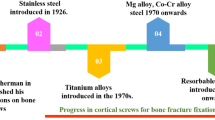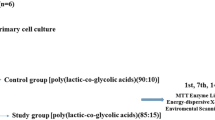Abstract
Bioabsorbable synthetic polymers have been studied for their possible application in absorbable internal fracture fixation devices. The current study examines the biological response of intramedullary bone to PLLA (poly-L-lactic acid). PLLA degrades at a rate sufficiently slow to be useful for fracture fixation and undergoes hydrolytic deesterification to form metabolites normally found in the body. Nevertheless, the lactic-acid-rich degradation products have the potential to significantly lower the local pH in a closed space surrounded by bone. It is hypothesized that this acidity may tend to cause abnormal bone resorption and/or demineralization.
PLLA (Medisorb, Du Pont), with a molecular weight of 1.0 × 105 daltons, was chosen for this study. PLLA coupons were made by heating the polymer pellets to 180°C and pressing them. Ultrahigh-molecular-weight polyethylene chambers with ingrowth channels running widthwise, were lined with coupons of the test material and with stainless steel (SS) and implanted in the femurs of eight skeletally mature hound dogs. Two dogs each were killed 3, 6, 12, and 24 weeks postoperatively.
From an associated in vitro study, the molecular weight of the PLLA was found to decrease with immersion time to 0.92, 0.85, and 0.69 of original molecular weights by 6, 12, and 24 weeks, respectively. Ingrown bone was seen between both PLLA and SS coupons, and no resorption areas existed between bone and the chambers at 3 and 6 weeks. By 12 weeks, no bone was found ingrown in the PLLA chambers. Indeed, femoral bone around the chamber had resorbed. By contrast, the amount of bone grown into the SS chambers increased and the femoral bone was in contact with the chamber. The affinity of intramedullary bone to PLLA was greater than that of SS at the early time periods. No inflammatory cells were seen. This may explain earlier claims of osteogenic potential. Once the degradation of PLLA had started (as reflected by the molecular weight data), the affinity of PLLA to bone reduced drastically. Not only the bone ingrowth between the PLLA coupons but also the bone surrounding the chamber was resorbed. This resorption of bone is probably caused by the influence of the degradation products of PLLA that increase osteoclastic activity. The degradation rate accelerated between 6 and 12 weeks. Though the resorption of bone around the chamber was not massive in this study, it might jeopardize bone union if it were used for internal fixation of a bone fracture. These findings are significant in that experimental α-polyester-based fracture fixation systems are currently in development and clinical trials in the United States, Europe, and Japan.
Similar content being viewed by others
References
Uhthoff HK, Bardos DI, Liskova-Kiar M: Current Concepts of Internal Fixation of Fracture. Springer-Verlag, New York, 1980.
Daniels AU, Chang MKO, Andriano KP: Mechanical properties of biodegradable polymers and composites proposed for internal fixation of bone. J Appl Biomater 1(1):57–78, 1990.
Spivak JM, Ricci JL, Blumenthal NC, Alexander H: A new canine model to evaluate the biological response of intramedullary bone to implant materials and surfaces. J Biomed Mater Res 24:1121–1149, 1990.
Bostman OM: Absorbable implants for the fixation of fractures. J Bone Joint Surg 73-A:148, 1991.
Author information
Authors and Affiliations
Rights and permissions
About this article
Cite this article
Suganuma, J., Alexander, H., Traub, J. et al. Biological Response of Intramedullary Bone to Poly-L-Lactic Acid. MRS Online Proceedings Library 252, 339–343 (1991). https://doi.org/10.1557/PROC-252-339
Published:
Issue Date:
DOI: https://doi.org/10.1557/PROC-252-339




